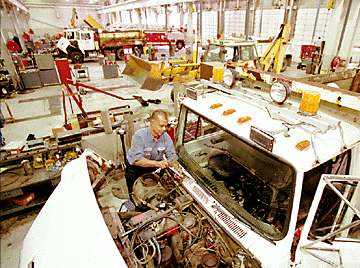

Indianapolis:
Innovation
can work
The city's incentive
By Rob Perez
plan is a model for making
governments more efficient
Star-BulletinEVERY month the city of Indianapolis monitors how many customers complain about garbage collection and how many building inspections are completed within half a day.
Another 250 or so performance standards also are checked, ranging from the amount of sewer lines cleaned to the number of lawns mowed to resolve code violations.
Why bother with such tedium?
The city uses those measures to determine whether offices are getting results that serve the public. If they are and the offices end a year under budget, part of the savings is distributed to affected employees as incentive pay.
That's just one way Indianapolis has substantially changed the way it does business in the 1990s.
With an emphasis on measuring outcomes, managers and rank-and-file workers constantly consider ways to become more productive because they ultimately share in the savings, officials say.
One offshoot: City workers now compete with private contractors when certain public services go out for bid.

The changes were born out of campaign pledges Mayor Stephen Goldsmith made before he was elected in 1991. His promises to dramatically cut staffing and aggressively pursue privatization contracts were seen as threats by the Indiana Council No. 62 of the American Federation of State, County and Municipal Employees.But instead of fighting Goldsmith's efforts, the city union accepted an administration offer to become a partner in the re-engineering, said Stephen Fantauzzo, the union's executive director.
"The threat of privatization brought about very, very quickly some major concessions and reforms" from the union, said Richard Rubin, an Indiana University professor.
By various measures, the results have been impressive, according to city and union officials. Staffing is down 25 percent, though no union members have been laid off. Wage increases have averaged about 6 percent yearly. Property tax rates have been cut three times.
While public employees are working harder than before, they feel more empowered in the process, said Skip Stitt, former deputy mayor of the city.
"Public employees are really smart folks," Stitt said. "They've just been told for years to leave their brains at the door when they come to work."
The Indianapolis workers have such a stake in the process that one group decided to forgo a negotiated pay raise to develop a more competitive bid for a job, which they won, Fantauzzo said. The payoff came at the end of the year when the incentive pay they got more than offset the bypassed pay raise.
The key to the Indianapolis system has been to focus not on how much money each department gets but on what it accomplishes with the funds received.
Another essential component has been to determine precisely how much it costs the government to provide a service -- something needed when evaluating private-sector bids against public ones.
That's the same approach Hawaii is taking. A new law sets up a managed competition process for making public vs. private comparisons. Even if a service is privatized, though, government layoffs are prohibited as a result.
County representatives said the law threatens their ability to sign long-term contracts.
United Public Workers head Gary Rodrigues said local governments currently can't determine the cost of providing a given service. Until they can, he said, "How can anyone stand up and say if we give it to the private sector it'll be more cost effective?"
Delving into the realm of managed competition and performance-based systems can be a murky proposition.
In Indianapolis, difficulties have come in deciding what outcomes to measure, especially in white-collar areas where outcomes aren't so clear, Stitt said. "You really struggle with that."
Once the standards are set, though, the public will have a more precise way to gauge government performance, leading to increased scrutiny and accountability, he said.
"If you do something innovative and make mistakes, you'll really get hammered for it," Stitt said.
Mishaps, however, will be inevitable, he said. The key is to adjust the system and move on.